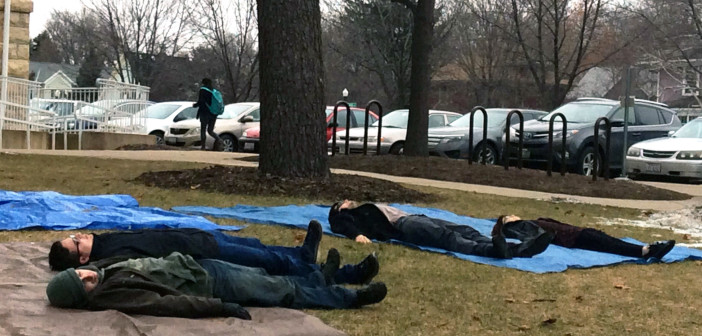Megann Horstead
Content Producer
Student Emily Canaday ’15 organized a die-in demonstration to create awareness and build community support for topics and issues related to race as part of North Central’s MLK Week.
Die-In demonstrations have ignited all-across the country with the topic of race coming up in the news in recent months.
The idea of holding a demonstration on campus came to Emily when talking to friends about incidents of police brutality and systemic racism.
“I found the main reaction was a growing malaise, students getting frustrated with the country that they live and feeling powerless to change these trends of racism,” Canaday said.
First, the media reacted to last year’s shooting of an unarmed black man named Michael Brown, who was a resident of Ferguson, MO.
That same summer, the media shifted its attention to the police officer that laid a chokehold upon Eric Garner, a resident of Staten Island, NY.
Canaday hoped the event would stir conversation and create awareness for issues of race.
“It’s easy to feel like you don’t have a lot of influence on the world… This is a mainly symbolic event, but I wanted to give other students this chance to do something, even if it was just symbolic.”
Sometimes students may not be aware of how largely racism continues to be an issue today.
Although issues related to race were all over the news last summer, others may not have been aware die-in demonstrations were taking place or recognized their purpose.
A die-in demonstration, as Canaday explained, “[Is] a peaceful demonstration… You’re supposed to get a whole bunch of people together and everyone just lies on the ground and pretends to be dead, completely still, not talking, not answering questions for a four-minute span.”
The four-minute span, as Canaday mentioned, is meant to represent the number of hours Michael Brown’s body laid upon the ground before it was retrieved by a medical transporter.
Canaday said the demonstration is more of a peaceful gesture than anything else. It’s not about bashing the police.
Students united on campus in a peaceful protest against violence on Jan. 22 in the grassy area between the Whites Activities Center and Old Main.
The demonstration was backed by a number of offices on campus, such as the Dean of Students, Multicultural Affairs, and Campus Safety.
Canaday said organizing the event was a challenge at times, especially being that she is a commuter student. She found it difficult with classes having resumed.
“I wanted to do this [demonstration]and say a student can actually accomplish this,” Canaday said. “The amount of support that I got from faculty was amazing.”
The event was originally scheduled to take place during the first week of winter term. Canaday said suggestions were made to move the demonstration to MLK Week because that’s when awareness is high.
The college had closed for D-Term when the Ferguson verdict came in and die-ins were being staged all across the country.
Director of the Office of Multicultural Affairs Dorothy Pleas commented on the event’s turnout.
“Passion about [police brutality and race]were high at that point,” Pleas said. When the media’s attention shifted, “I think that might have been part of issue in getting a turnout. This issue was not at the forefront of their minds because it was a little while after things had occurred.”
Pleas added that it’s exciting to see people from across the nation strive to keep race in the conversation.
“I think it’s just really exciting to see, especially with the 50th anniversary of Selma, Montgomery Marches. You watch the movie “Selma” and you see what people have done. Young people like Emily are trying to do similar things now and that’s exciting to see.”
Referring to the event, Canaday explained how the demonstration creates a sense of togetherness.
“It’s automatically bringing people who are socially aware and actually care about the event into one place,” Canaday said. “I think it also give a sense that I am not alone in my opinion. Like I said it’s easy to feel disenfranchised as a lone college student. I think it’s an encouraging kind of unity as well.”
Pleas noted how the demonstration brings people together who are representing all different backgrounds.
“I think it was nice that Emily, as a white student, was able to take handle of this and say ‘I want to put this on even though this maybe doesn’t directly affect me but I feel empathy about it.’”
Social media is another way people have chosen to keep issues of race in the forefront.
Pleas said she thinks social media campaigns such as #BlackLivesMatter and #AllLivesMatter are important with the way young people communicate via Facebook, Twitter and Instagram.
“Seeing the sheer numbers of people who really care about it, is important. But then if you don’t follow that up with action, then what does that really mean? If people aren’t really doing anything… then it’s just sort of hash tag at that point.”
Pleas explains why she hopes holding the demonstration will encourage people to be more vocal and more willing to research an issue.
“People will see that a student can do things like this,” Pleas said. “Maybe next time when a big issue comes up further in the year…” others may choose to do something as a continuance of that.

